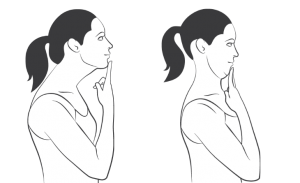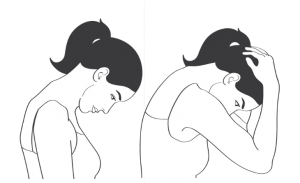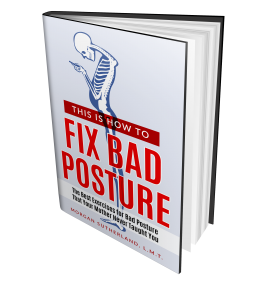Do you suffer from frequent tension headaches or neck pain? Forward head posture, often caused by prolonged sitting and tech use, can be a major culprit. These headaches can leave you feeling trapped in pain, but relief is possible.
In this post, I’ll share four simple neck stretches that target the muscles responsible for tension headaches, helping you find relief fast.
What Causes Tension Headaches?
Forward head posture can cause chronic shortening of the suboccipitals, the muscles at the base of the skull, whose main function is to rock and tilt the head into extension. When these muscles tighten, they restrict blood flow and create trigger points, resulting in a headache-like pain pattern.
Next to back pain, a stiff neck and tension headaches are some of the most common complaints that clients come to my massage office with. In fact, most of the time, tension-related headaches are cervicogenic, meaning the head pain is referred from the bony structures or soft tissues of the neck.
Tension headaches are among the most common types of headaches I see in my practice, with symptoms ranging from a mild to moderate pain that feels like a tight vice around your head. Mountains of stress, coupled with poor posture, can easily trigger these headaches.
While over-the-counter pain relief can sometimes help, more often than not, the pain returns. Thankfully, the following stretches can offer a natural solution to relieve tension headaches and neck pain.
4 Best Neck Stretches for Tension Headaches
Here are four neck stretches I recommend to my clients. These exercises target the neck muscles responsible for tension headaches and can help reduce pain.
1. Chin Tuck

The chin tuck exercise is designed to reverse forward head posture by strengthening the neck muscles that support proper alignment. By training your neck to stay in a healthier position, this simple stretch can help reduce the tension that leads to headaches and neck pain.
Over time, performing chin tucks can significantly improve your posture, allowing your head to rest in its proper alignment and relieving strain on the neck muscles.
Step-by-Step Instructions:
- Start by sitting or standing with your shoulders rolled back and down, in a relaxed posture.
- Look straight ahead and place two fingers on your chin.
- Slightly tuck your chin and gently move your head straight back, as though you’re trying to create a double chin.
- Keep your chin level as you do this—don’t let your head tip forward or backward.
- Hold the position for 3-5 seconds, feeling the stretch in the back of your neck.
- Release and return to your starting position.
- Repeat this exercise 10 times, gradually increasing the hold duration as your muscles adapt.
By doing the chin tuck regularly, you’ll gradually strengthen the deep neck muscles that help maintain proper head posture, reducing strain on your neck and relieving tension headaches.
2. Neck Flexion

The neck flexion exercise is perfect for reducing tightness along the back of the neck. It helps to lengthen muscles that often become strained from forward head posture and tension headaches.
Whether you spend a lot of time looking down at your phone or sitting at a desk, this stretch will help reverse that strain and provide relief. By regularly practicing this movement, you’ll feel a noticeable release of pressure in your neck and upper back.
Step-by-Step Instructions:
- Begin in a seated or standing position with your head and neck in a neutral position.
- Slowly bend your head forward, bringing your chin toward your chest.
- If you can’t reach your chest, flex your neck as far as you can comfortably go without straining or causing pain.
- Feel the gentle stretch along the back of your neck as you lower your head.
- Hold the stretch for 3-5 seconds, keeping your shoulders relaxed.
- Slowly return to the starting position by lifting your head back up.
- Repeat this stretch 10 times, taking care not to overstretch or cause discomfort.
This stretch can be particularly helpful if you spend a lot of time looking down at a phone or computer, as it relieves the strain on your neck caused by poor posture.
3. Chin Tuck with Overpressure

The chin tuck with overpressure takes the basic chin tuck exercise a step further by applying gentle pressure for a deeper stretch. This helps release built-up tension in the neck muscles and gives you greater control over your posture.
By applying extra pressure, you’re able to intensify the stretch, which helps address deeper muscle tightness that may be contributing to your headaches.
Step-by-Step Instructions:
- Start by positioning yourself in the same way you would for the basic chin tuck.
- Place two fingers on your chin and gently press backward as you tuck your chin, increasing the stretch.
- Keep applying light pressure with your fingers while moving your head straight back.
- Sustain this end-range position for 1-2 minutes to achieve a deep stretch.
- After holding the stretch, slowly release and return to the starting position.
- Repeat this exercise a few times throughout the day to enhance the effect.
This exercise provides an effective way to address deeply rooted tension and significantly improve neck mobility, helping prevent tension headaches.
4. Neck Extension with Rotation

The neck extension with rotation stretch helps relieve tightness in the neck and shoulders by stretching muscles that pull your head forward. This exercise focuses on improving your range of motion while relieving the tension that leads to headaches.
It’s particularly effective in releasing stiffness in the upper neck and restoring balance to your posture. With consistent practice, this stretch can help restore mobility and relieve the lingering stiffness that often contributes to tension headaches.
Step-by-Step Instructions:
- Start by positioning your head in a chin tuck.
- From this position, slowly tilt your head backward, raising your chin and looking upward.
- While your head is tilted back, gently rotate your head from side to side, keeping the movement slow and controlled.
- Strive to move your head further back with each rotation, but avoid straining your neck.
- After a few rotations, return your head to the neutral position.
- Repeat the exercise 5-10 times, focusing on maintaining control throughout the movement.
This stretch helps open up the front of your neck, alleviating tension in the muscles that are often shortened due to forward head posture. It’s a great way to reduce neck stiffness and tension headaches.
Client Testimonials: Relief for Neck Pain and Headaches
Here’s what some of my clients have experienced:
“I have gone to massage therapists for over a decade for chronic neck pain. Morgan is one of the best massage therapists I’ve visited. His skill and knowledge were apparent within minutes of my initial session.”
– A.R., Client
“I’ve been going to Morgan for years. At my appointment on Tuesday, he spent a lot of time on my neck because I had pain there for a couple of weeks. Two days later, the pain is still gone. Relief!”
– Wendy G., Client
Final Thoughts

Incorporating these neck stretches into your routine can help improve posture and prevent tension headaches. Self-massage is also effective for addressing trigger points for deeper relief. In my book, This Is How To Fix Bad Posture, I share techniques to self-massage three common trigger points that are often responsible for neck pain and tension headaches.
For more tips on how to protect your back and improve your posture, check out my book, This Is How To Fix Bad Posture. It’s packed with practical exercises perfect for creating a healthier lifestyle from the comfort of your own home.
Ready to experience relief firsthand? Book your in-home massage here and say goodbye to tension headaches for good!

